AMD Ryzen 5000G Cezanne APUs: Shipping to OEMs Now, Coming To DIY Later This Year
Zen 3 meets Vega
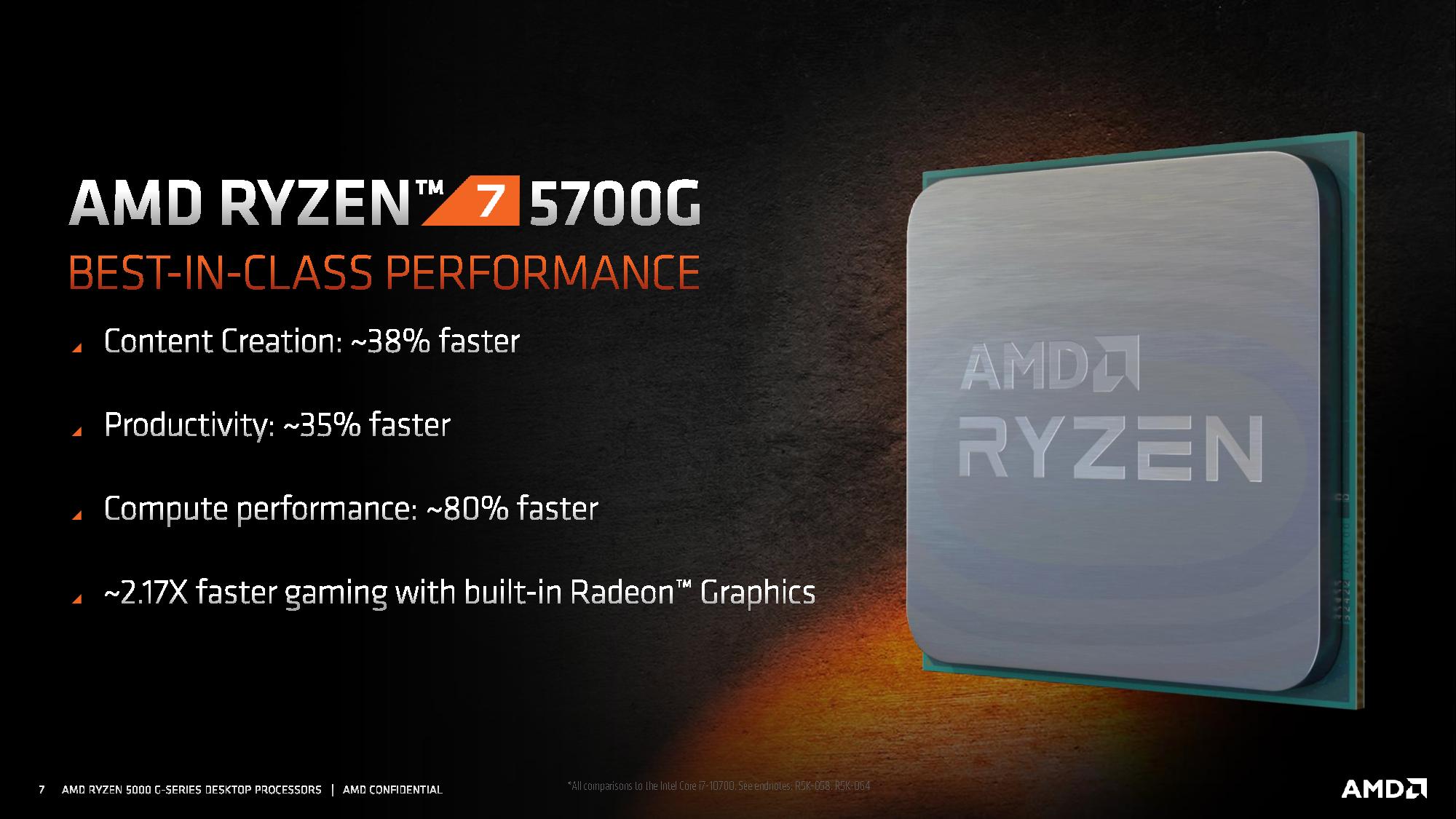
AMD has announced that its 7nm Ryzen 5000G series APUs, codename Cezanne, are now shipping to OEMs with availability for the DIY/retail market coming later this year. AMD announced three primary 65W models that span from four Zen 3 cores up to eight cores, accompanied by Vega graphics that span from 6 graphics cores to eight. AMD hasn't shared pricing for these processors yet — that information will likely come during the retail launch later this year. In either case, we are sure that these new chips will rank on our list of Best CPUs and Best Cheap CPUs.
Compared to Intel's Core i7-10700, AMD claims the chips are 38% faster in content creation, 35% faster in productivity, and are up to 2.17X faster in gaming, which comes courtesy of the built-in Radeon Vega graphics engine. AMD also provided plenty of benchmark comparisons, albeit against Intel's 10th-gen processors and not the Rocket Lake chips that come with the more potent UHD Graphics 750 engine powered by 32 EUs with the Xe architecture.
As with all Zen 3 processors, the Ryzen 5000G chips step up to a faster DDR4-3200 interface, which will certainly help the integrated GPU in gaming performance. However, AMD has stuck with the PCIe 3.0 interface found on all of its current-gen APUs. The chips will find their way into 500-series and some 400-series motherboards, though support on the latter will vary by vendor. As expected, AMD also released three low-power 35W variants with lower base frequencies to fit inside more restricted power/thermal environments and smaller builds.
Given the ongoing graphics card shortages, these newly revamped APUs are a welcome sight for the gaming market. That is if AMD can keep them in stock, of course. In either case, AMD's willingness to bring these APUs to market is laudable given that its previous-gen Ryzen 4000 series APUs only landed in the OEM/pre-built market. Luckily, we grabbed the Ryzen 7 4750G from the grey market so we could take it for a spin. As you would imagine, these new 5000G chips will also make their way to these quasi-retail outlets soon, too, but it won't be too long before we can find them in the normal retail haunts.
AMD Ryzen 5000G G-Series Specifications
| CPU | Cores/Threads | Frequency (Up to) Boost / Base | Graphics Cores | Graphics Frequency | TDP | Cache |
| Ryzen 7 5700G | 8 / 16 | 3.8 / 4.6 | RX Vega 8 | 2100 MHz | 65W | 20 MB |
| Ryzen 7 4700G | 8 / 16 | 3.6 / 4.4 | RX Vega 8 | 2100 MHz | 65W | 12 MB |
| Ryzen 5 5600G | 6 / 12 | 3.9 / 4.4 | RX Vega 7 | 1900 MHz | 65W | 19 MB |
| Ryzen 5 4600G | 6 / 12 | 3.7 / 4.2 | RX Vega 7 | 1900 MHz | 65W | 11 MB |
| Ryzen 3 5300G | 4 / 8 | 4.0 / 4.2 | RX Vega 6 | 1700 MHz | 65W | 10 MB |
| Ryzen 3 4300G | 4 / 8 | 3.8 / 4.0 | RX Vega 6 | 1700 MHz | 65W | 6 MB |
The Ryzen 5000G lineup spans from four to eight cores, with the key addition being the Zen 3 architecture that provides a 19% IPC uplift over the Zen 2 architecture used in the previous-gen Ryzen 4000G models. We also see higher clock rates across the lineup, with peak boost speeds now weighing in at 4.6 GHz for the eight-core 5700G, whereas the previous-gen models topped out at 4.4 GHz. We also see that base clocks have increased by 200 MHz for all 65W chips.
The Zen 3 architecture also grants higher L3 cache capacities than we've seen with AMD's past APUs. For instance, the eight-core 16-thread Ryzen 7 5700G now has 20MB of L3 cache compared to its eight-core predecessor that came with 12MB. These are the natural byproducts of the Zen 3 architecture and should benefit general iGPU performance, too.
AMD continues to pair the chips with the Vega graphics architecture, just as it did with the 4000-series APUs, but AMD reworked the architecture for its last go-round — the reworked RX Vega graphics delivered up to ~60% percent more performance per compute unit (CU) than its predecessors, which equated to more graphics performance from fewer CU. We aren't sure if AMD has made a similar adjustment this time around, but we've reached out for more detail. We do know that the graphics units run at the same frequencies for each model.
Get Tom's Hardware's best news and in-depth reviews, straight to your inbox.
All of the chips come with a 45W to 65W configurable TDP (cTDP), broadening the range of potential uses for these higher-end Ryzen 5000G APUs. If you need to dip below the 45W range, you would look at the GE Models below.
| CPU | Cores/Threads | Frequency (Up to) Boost / Base | Graphics Cores | Graphics Frequency | TDP | Cache |
| Ryzen 7 5700GE | 8 / 16 | 3.2 / 4.6 | RX Vega 8 | 2000 MHz | 35W | 20 MB |
| Ryzen 7 4700GE | 8 / 16 | 3.1 / 4.3 | RX Vega 8 | 2000 MHz | 35W | 12 MB |
| Ryzen 5 5600GE | 6 / 12 | 3.4 / 4.4 | RX Vega 7 | 1900 MHz | 35W | 19 MB |
| Ryzen 5 4600GE | 6 / 12 | 3.3 / 4.2 | RX Vega 7 | 1900 MHz | 35W | 11 MB |
| Ryzen 3 5300GE | 4 / 8 | 3.6 / 4.2 | RX Vega 6 | 1700 MHz | 35W | 10 MB |
| Ryzen 3 4300GE | 4 / 8 | 3.5 / 4.0 | RX Vega 6 | 1700 MHz | 35W | 6 MB |
Here we can see the new 35W models, which aren't as exciting for regular users but are a boon for HTPC and SFF enthusiasts. As expected, base clocks are lower than the 65W models, but that's needed to squeeze into the 35W TDP envelope. However, AMD retains the high single-threaded boosts, which is impressive.
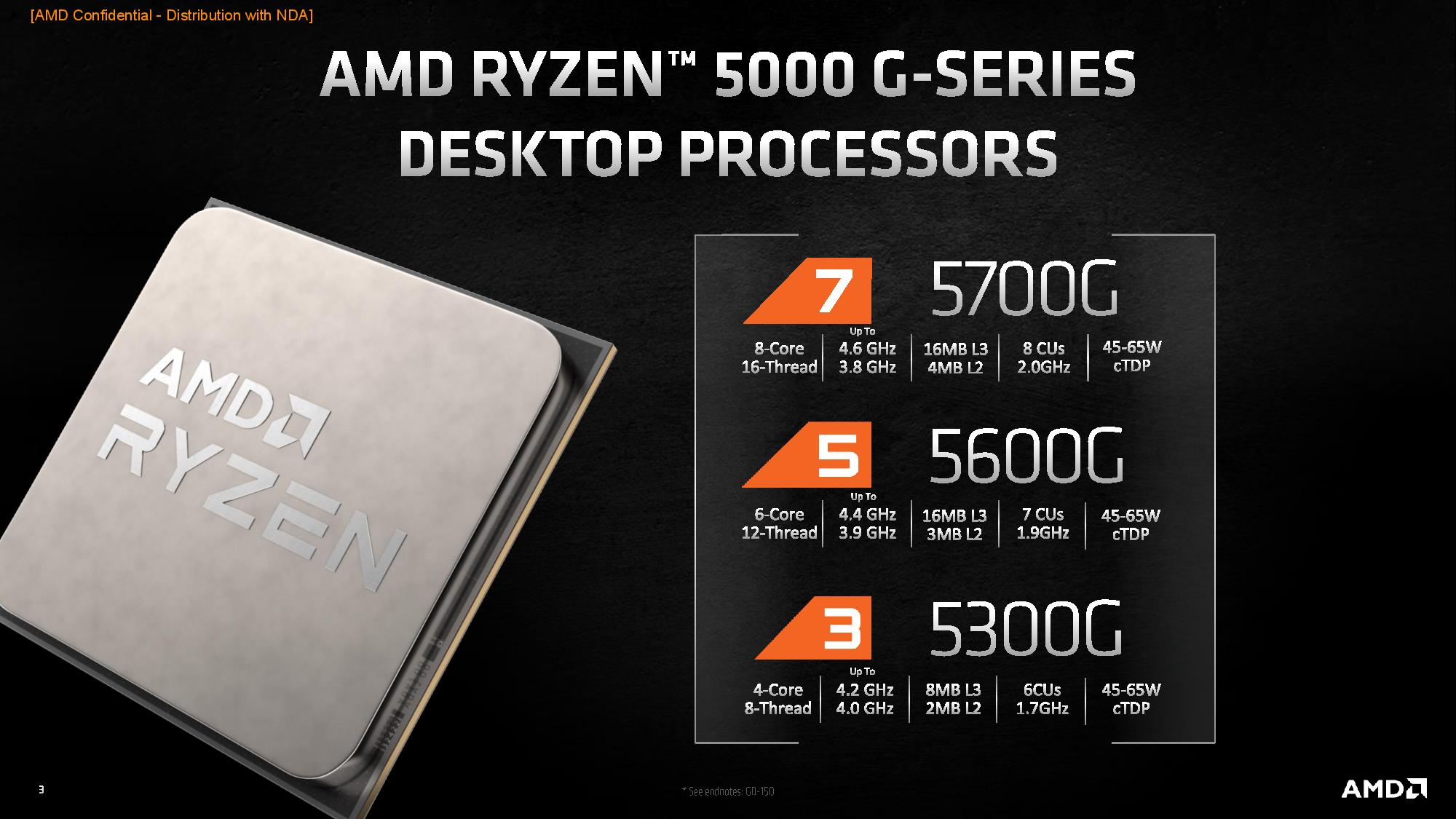
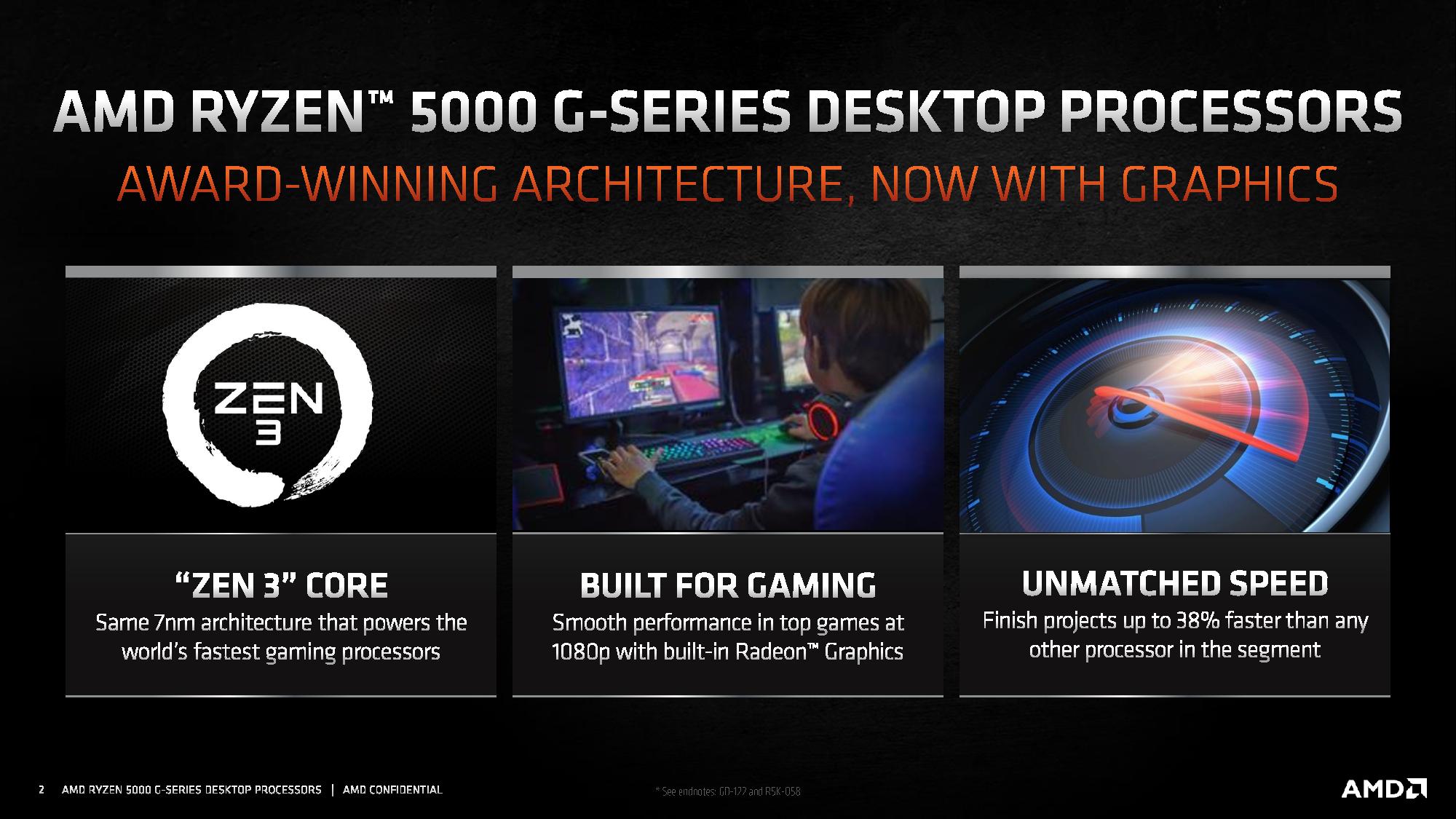
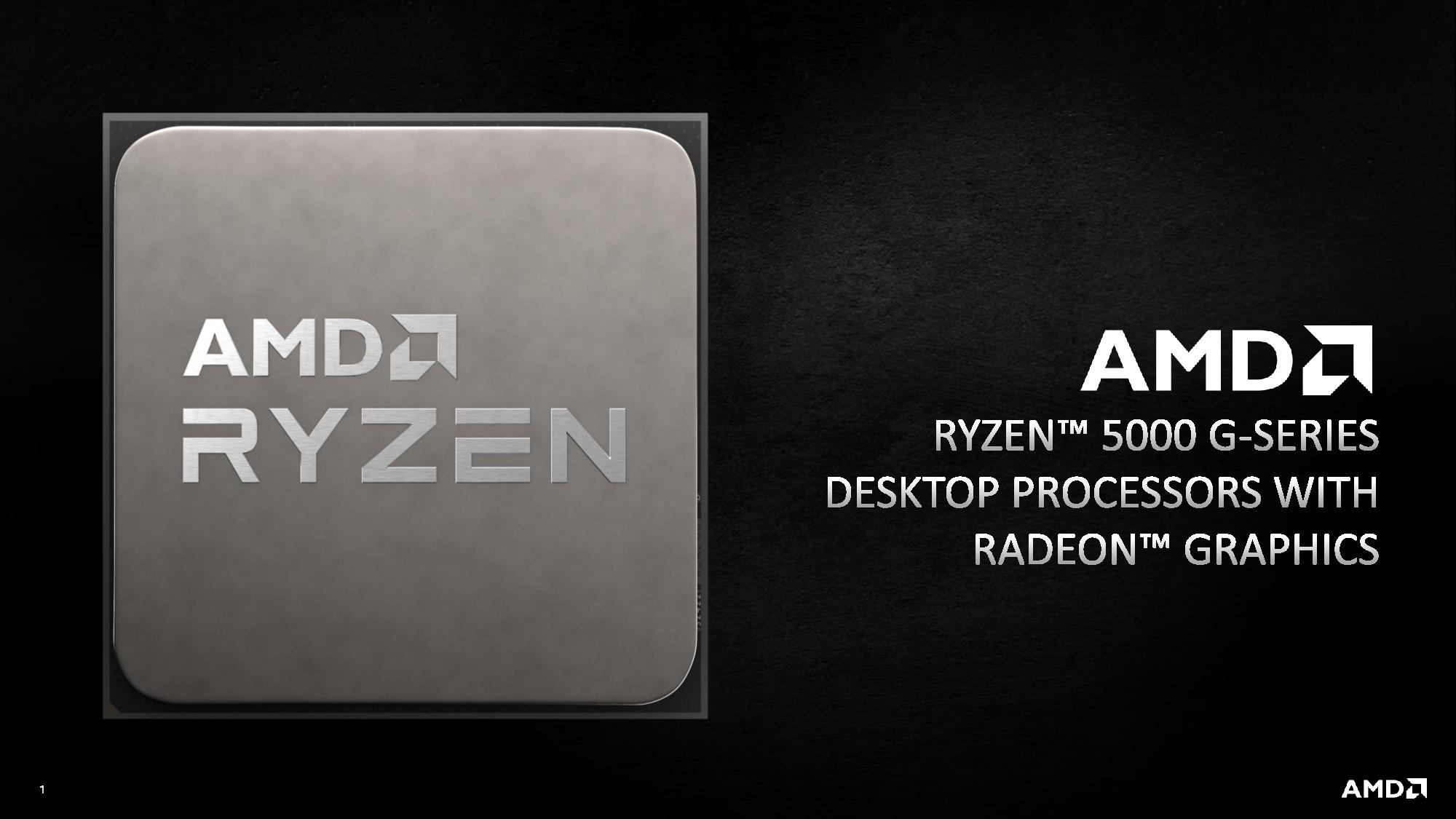
AMD Ryzen 5000G Performance Claims
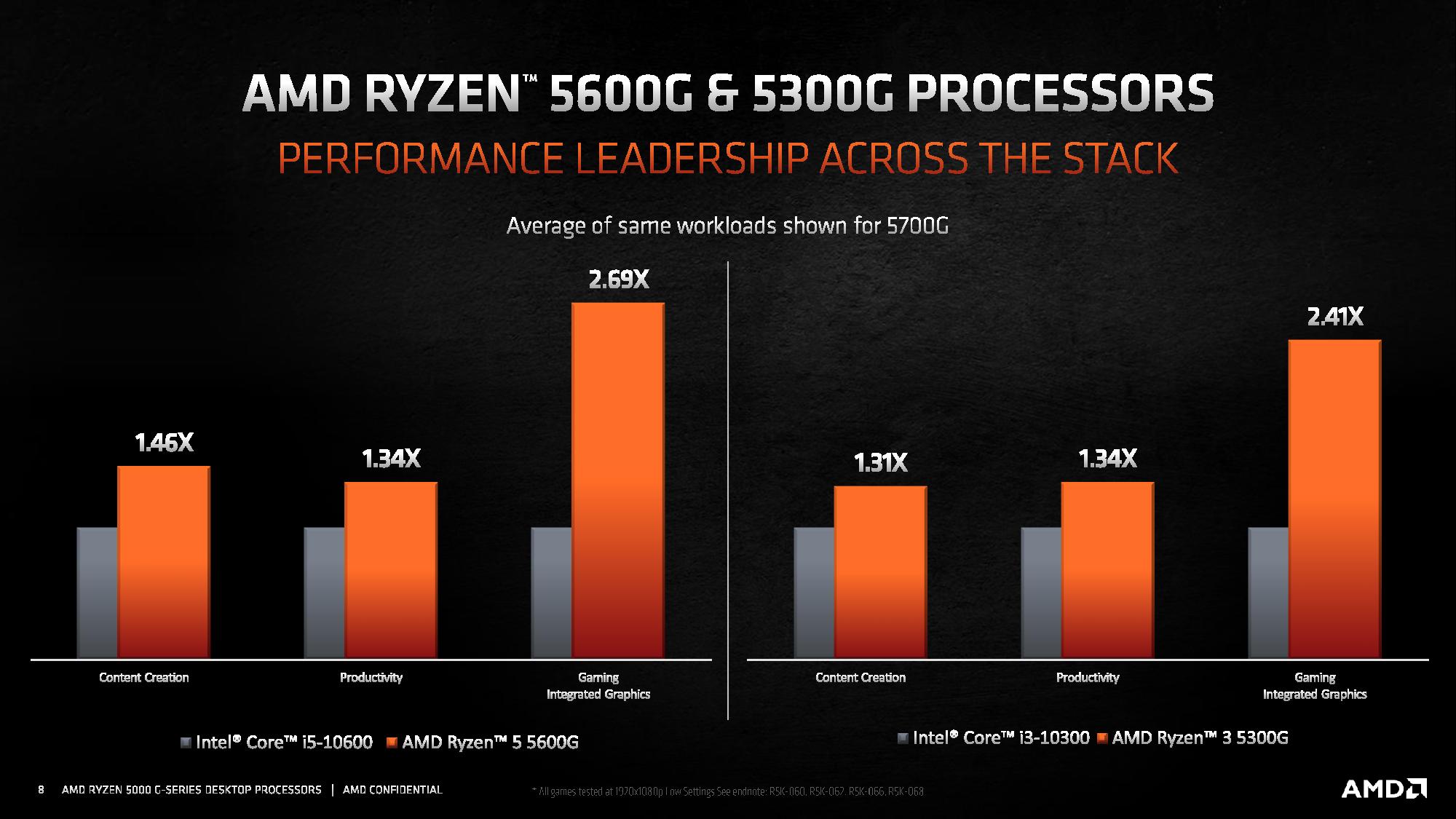
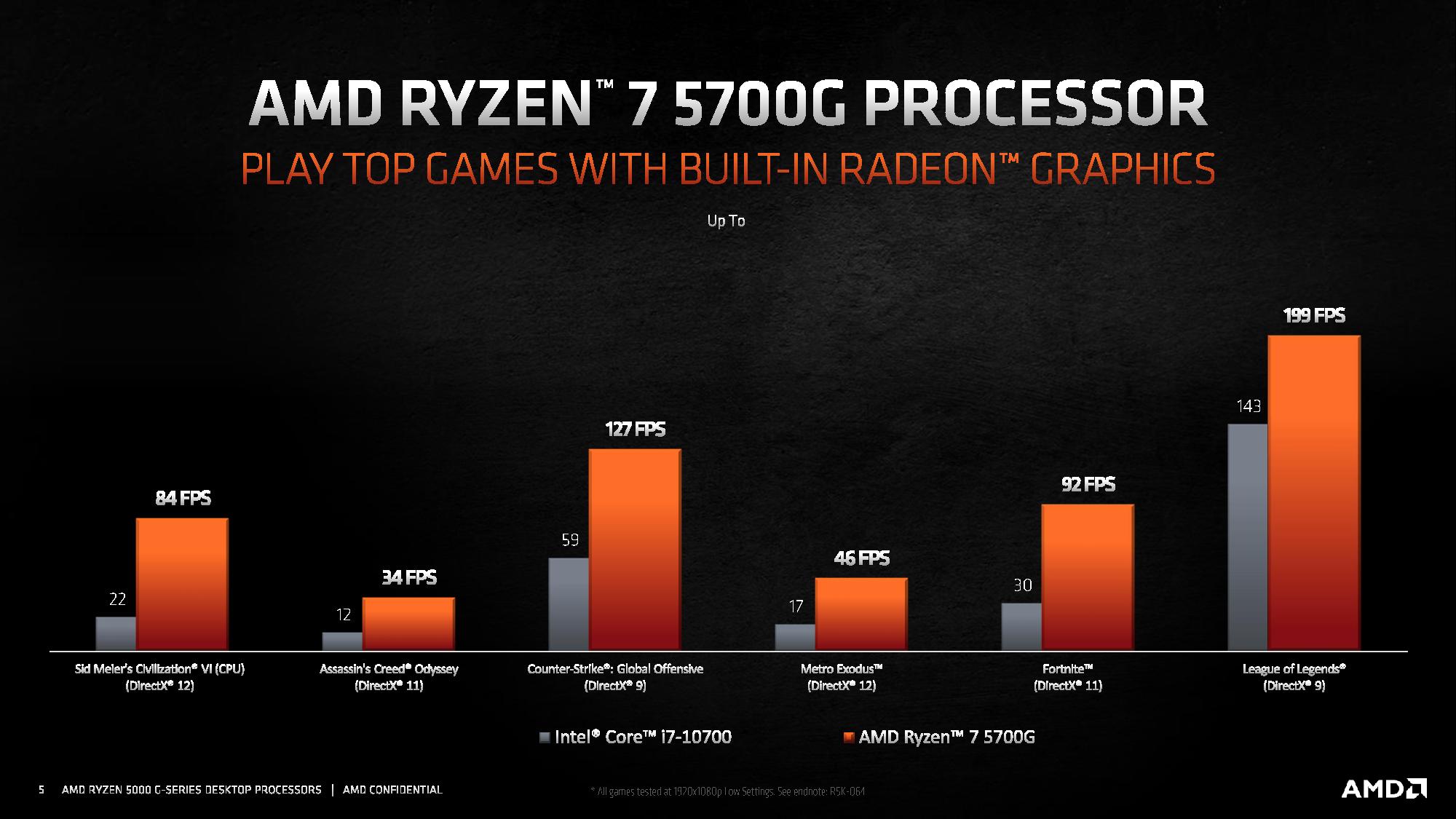
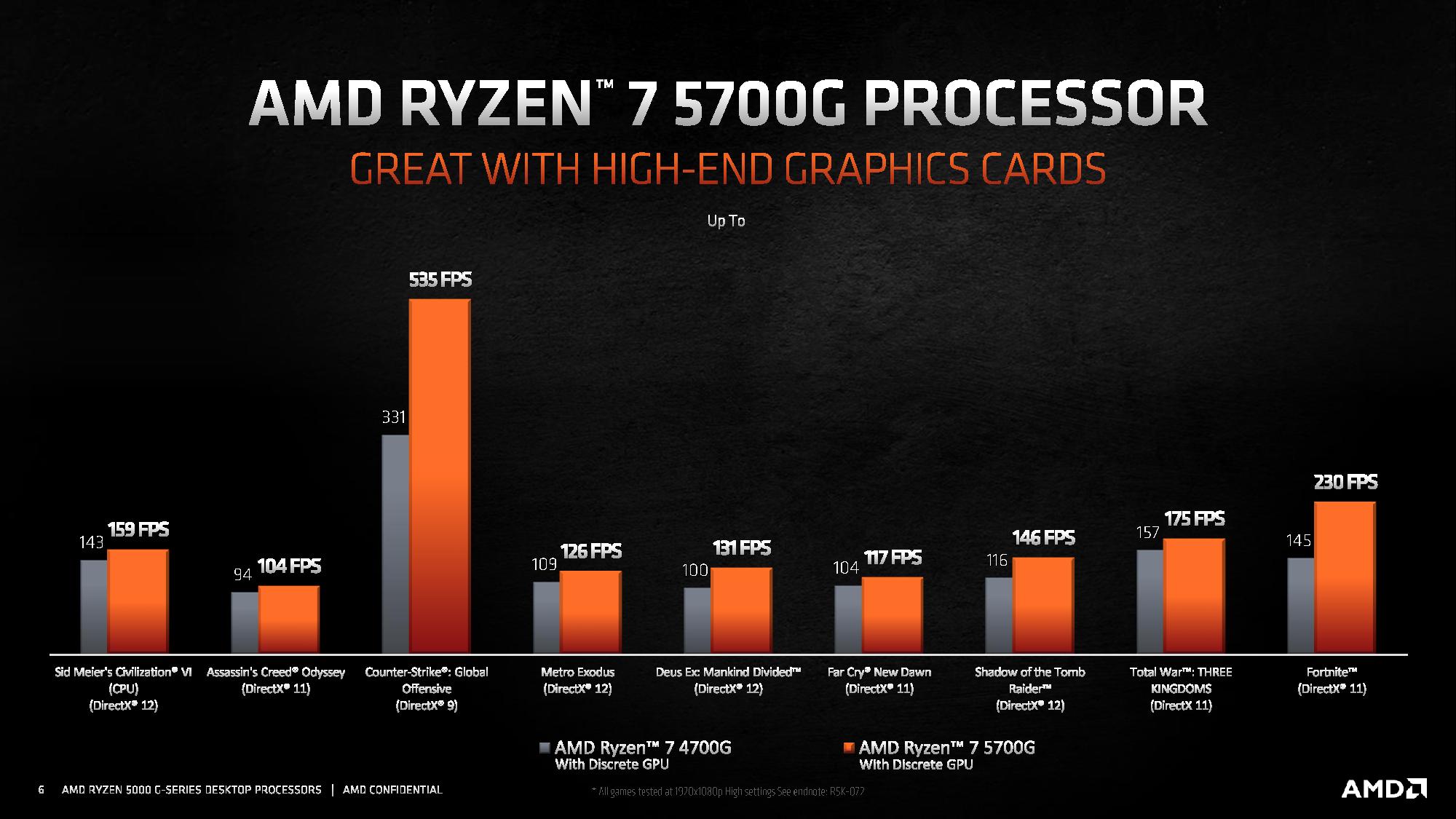

AMD presented plenty of comparisons to Intel's Core i7-10700 and the Core i5-10600, but bear in mind that these are Intel's previous-gen Comet Lake processors. That means these results are not representative of performance with the 11th-gen Rocket Lake chips that come with a significantly upgraded Xe UHD Graphics 750 engine that's powered by 32 EUs. As per usual, take any vendor-provided benchmarks with the requisite grain of salt. The test notes are at the end of the album.
We've already seen listings of the Pro variants for commercial systems, but there are very few details about systems that will come with the consumer Cezanne chips. We expect that several vendors will announce new pre-built systems with the APUs over the coming weeks. We'll update as we learn more.

Paul Alcorn is the Editor-in-Chief for Tom's Hardware US. He also writes news and reviews on CPUs, storage, and enterprise hardware.
-
waltc3 Also, bear in mind that all of Intel's comparative advertising today for it's latest gen is done against AMD GPUs/APUs 1-2 generations back from current AMD gen....;) AMD has big plans for the mobile markets--the laptop OEMs are getting first dibs because they make up the huge share of the laptop market--a market where DIY doesn't even exist...;) AMD is going in hard on the mobile market segment for laptops. Going to be an interesting year once the supply situation resolves.Reply -
InvalidError Reply
I would guess similarly to the 4000-series APUs vs 3000-series CPUs: the APUs will lose where L3$ is more important, win where the lower latency monolithic design gets to flex.rgd1101 said:Wonder how the 5700G compare to the 5800(non-x)
Prices are likely going to be steep. -
HideOut I just dont get no PCIe gen 4 though. with the 4000 series it was acceptable, but this is getting rediculous. A lower end to mid tier 5000 apu would be an awesome raid server/nas if it had 4x. If you want to go AMD right now you have to use slower storage controllers or cough up for a video card of some sort if you need to control it locally. We all know that GPUs are easy to get too.Reply -
jimhood82 ReplyHideOut said:I just dont get no PCIe gen 4 though. with the 4000 series it was acceptable, but this is getting rediculous. A lower end to mid tier 5000 apu would be an awesome raid server/nas if it had 4x. If you want to go AMD right now you have to use slower storage controllers or cough up for a video card of some sort if you need to control it locally. We all know that GPUs are easy to get too.
Do you run a 100G network at home? If not, PCI-E Gen 3 drives are already 3 times faster than 10G networks even support. -
salgado18 Reply
No, but a professional may be interested in a PCIe 4.0 SSD, with double the bandwidth and double the IOPS.jimhood82 said:Do you run a 100G network at home? If not, PCI-E Gen 3 drives are already 3 times faster than 10G networks even support.
I guess it may be physical space for the controller, or heat, or some other technical reason. It's still unacceptable that the second generation doesn't have it, especially with a powerfull 8-core CPU. -
hotaru251 curious as to how it compares to the x for gaming performance...cause atm gen 4 pci isnt useful (and can always upgrade cpu when stuff uses it later in yrs) as the igpu might be worth it (as if ur gpu dies atm ur gonna be hurting)Reply -
jimhood82 Reply
That makes no sense in context. I was replying to someone complaining that PCI-E 3.0 would hold back performance for NAS applications. Which, without 100G-E, it can't. In fact, even 25Gig-E is still going to be saturated. But now, you are talking about professional use that would demand all this performance... sorry, do you have a single use-case? Something where a pro would pick up a low-end APU and expect the kind of throughput you are talking about? Something where a 10G interface wouldn't be the bottleneck?salgado18 said:No, but a professional may be interested in a PCIe 4.0 SSD, with double the bandwidth and double the IOPS.
I guess it may be physical space for the controller, or heat, or some other technical reason. It's still unacceptable that the second generation doesn't have it, especially with a powerfull 8-core CPU.
Frankly, I think you folks are simply reaching for something to nitpick over. In context, that APU seems quite well positioned. Apart from the Vega graphics being ancient and a poor fit for modern gaming. -
InvalidError Reply
And 3.0x8 is going to be a huge bottleneck if 4GB GPUs remain the only remotely affordable things going into the foreseeable future. It may not be much longer before 6GB GPUs need to use system RAM to cover moderate VRAM deficiency too.jimhood82 said:In context, that APU seems quite well positioned. Apart from the Vega graphics being ancient and a poor fit for modern gaming.